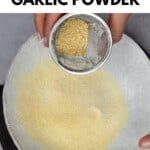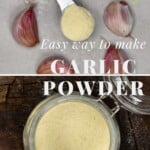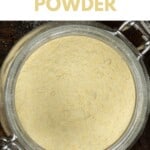This post may contain affiliate links. Please read our disclosure policy.
How to make garlic powder at home with one of three methods (dehydrator, oven, or air drying) – perfect for flavoring and garnishing tons of recipes and food!
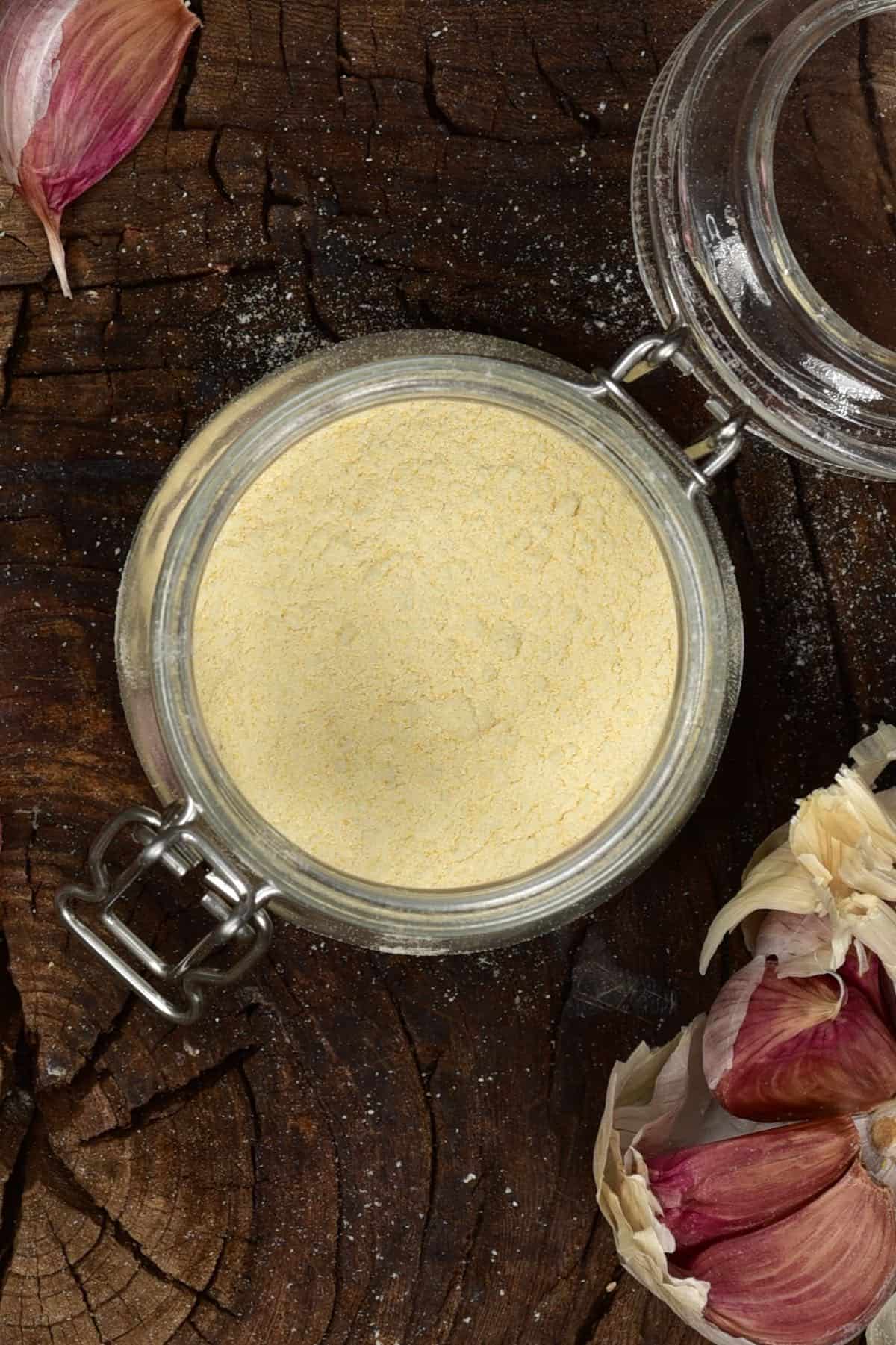
If you haven’t already spied my garlic flakes, onion flakes & powder, and everything bagel seasoning, then you may not be aware that I’m currently on a bit of a garlic and onion craze – leading to this garlic powder. Then again, if you check out my DIY posts, you’ll notice I’ve been grinding and ‘powdering’ ingredients like nobody’s business!
I love garlic powder and how handy it is for those days when you’re going for effortless meals and don’t want to handle fresh garlic. Not only is it cost-efficient (especially if you’re able to find cheap bulk garlic cloves), but you get to avoid any fillers and anti-caking chemicals used in various grocery store options, and the quality and flavor is usually far better too!
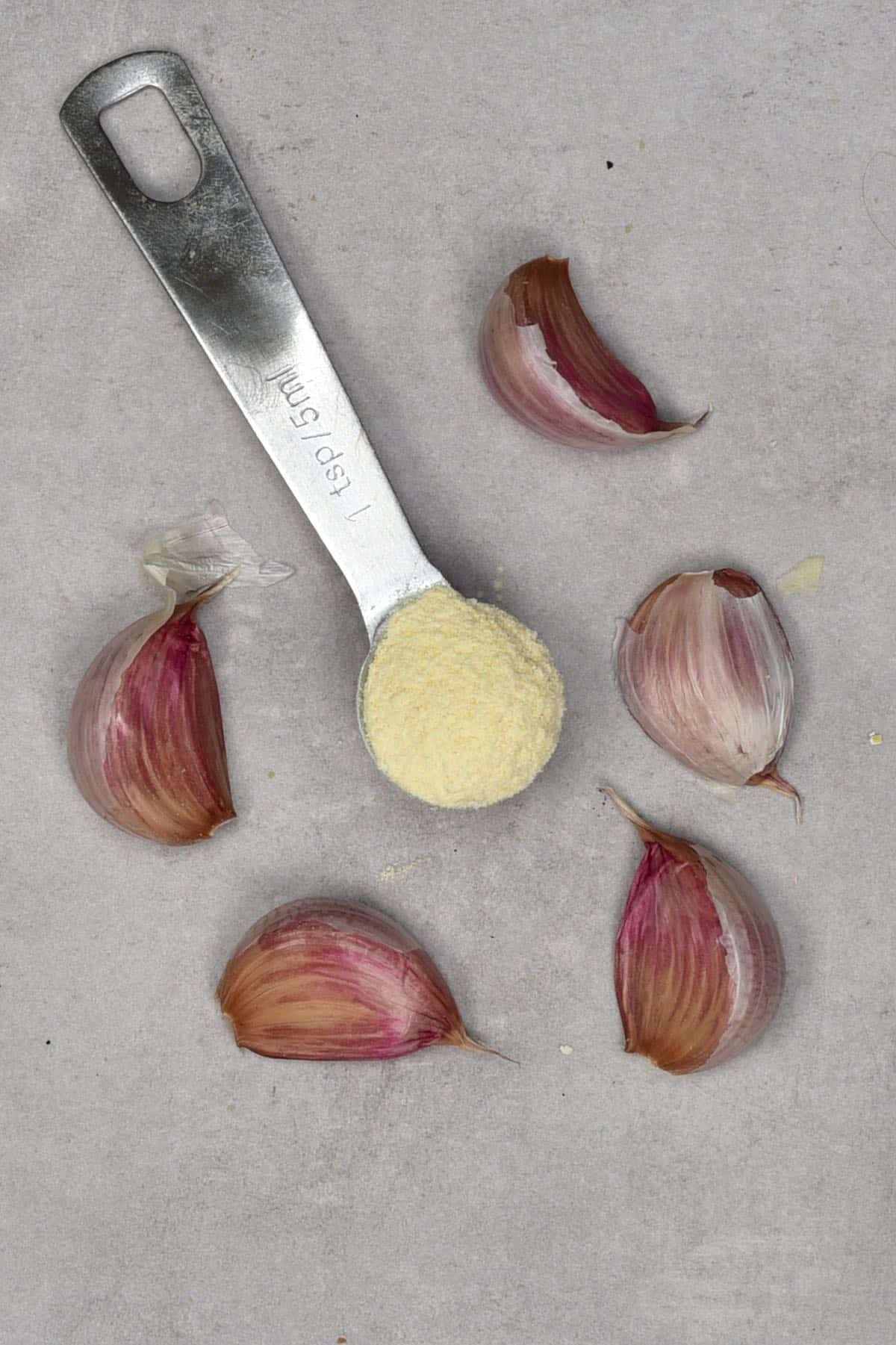
Even better, all you need to make this garlic powder is fresh garlic and either a food dehydrator, oven, or a well-ventilated room with sunlight (for those in warmer climates!).
Want to save this recipe?
The Step By Step Instructions
No matter which method you use to dehydrate the garlic, there are just three steps. Peeling, slicing, and dehydrating. The only thing that changes is the method of dehydration and how finely you mince/slice the garlic.
Step 1: Prepare the garlic
First, peel the garlic cloves. I like to make this step faster by placing them in a large lidded container and shaking for 20-30 seconds, to loosen the skins.
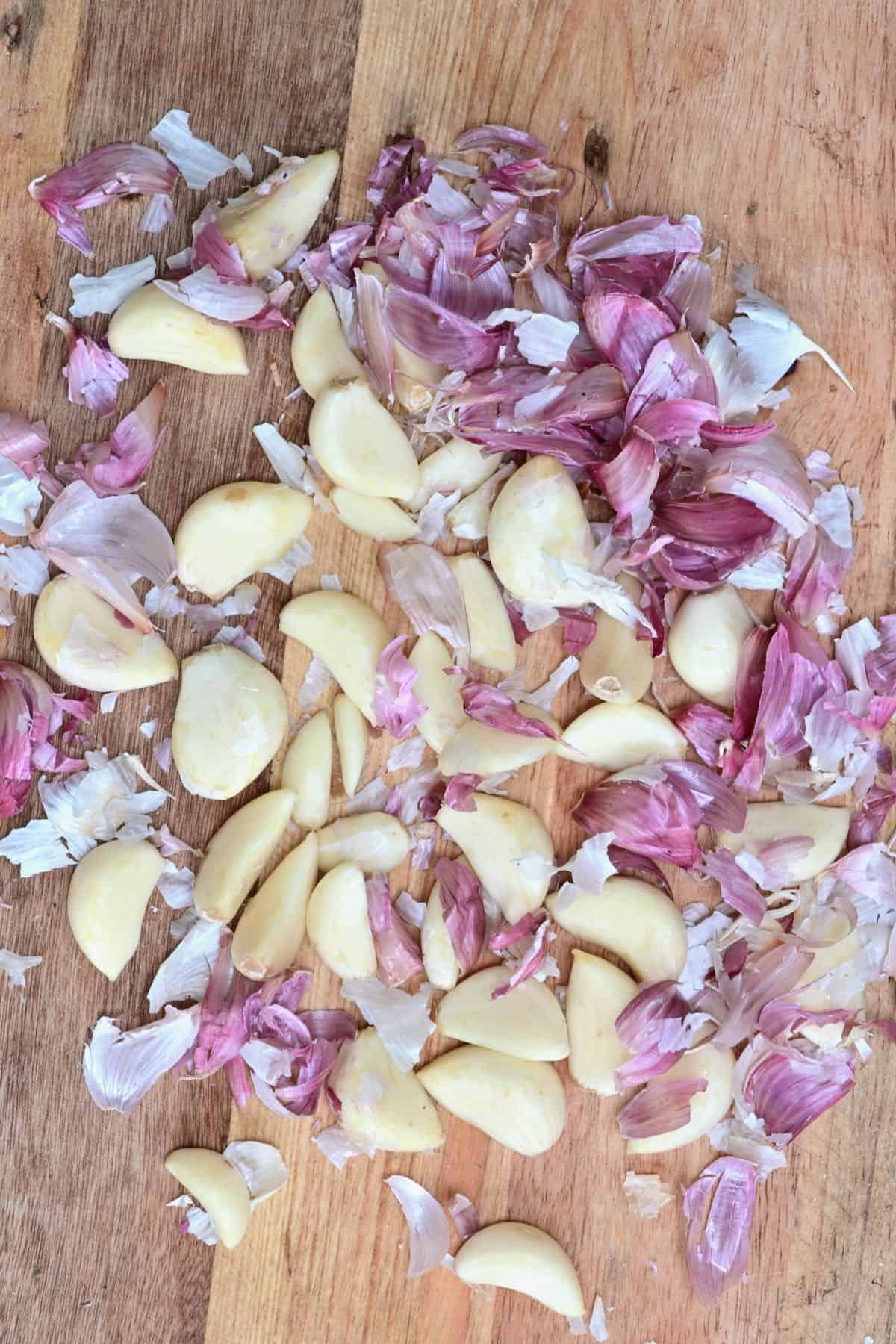
Then, slice or mince the garlic. You can slice it with either a garlic slicing tool, peeler, mandoline, or sharp knife. Alternatively, use a food processor/chopper and pulse until you have a chunky minced garlic consistency.
Try to keep the slices even in thickness and no thicker than 1/8 inch at absolute maximum, 1/16 inch if you can manage it.
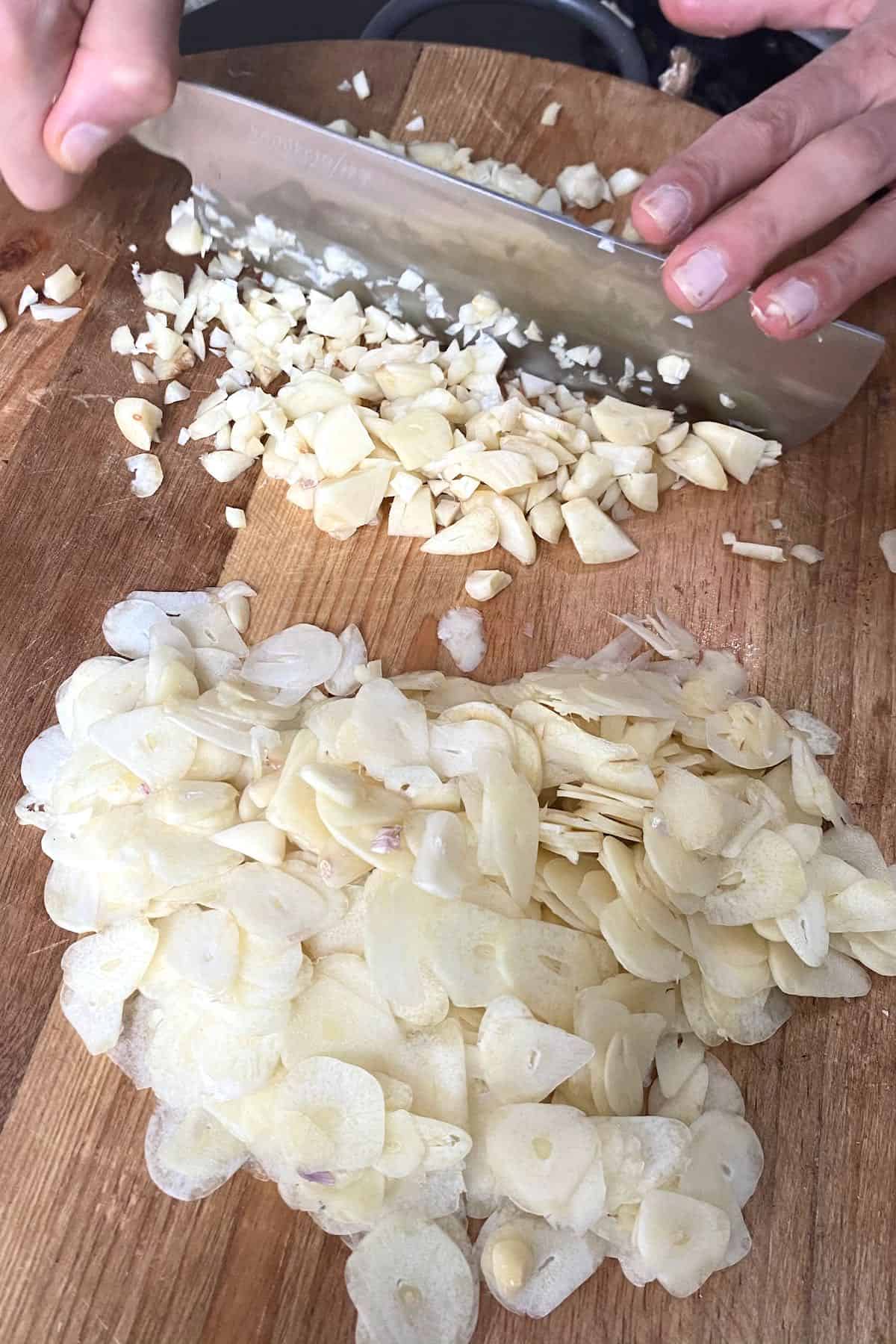
Step 2: Dehydrate the garlic
In a dehydrator
Lay the garlic onto the dehydrator trays, making sure that they don’t touch too much and are in a single layer. The more space between them, the quicker they will dry.
Dry in the dehydrator at 66ºC/150ºF for 6-8 hours (if high humidity, around 80%) or 4-6 hours (if low humidity).
To check if they’re ready, pick one up. If it’s bendy at all, then it’s not ready. If it snaps, then it’s ready.
In An Oven
Spread the garlic over parchment-lined baking sheets, making sure the pieces don’t touch.
Place the trays in the oven at the lowest temperature your oven goes to. It’s best if it’s between 54-66ºC/130-150ºF. If your oven doesn’t go as low as that, then choose the lowest temperature and prop open the door a few mm’s to allow the steam to escape as the garlic dries and help the process along.
Chef’s note: To prop the door open, you can use the handle of a wooden spoon or something else reasonably heat-proof (though it won’t get too hot)
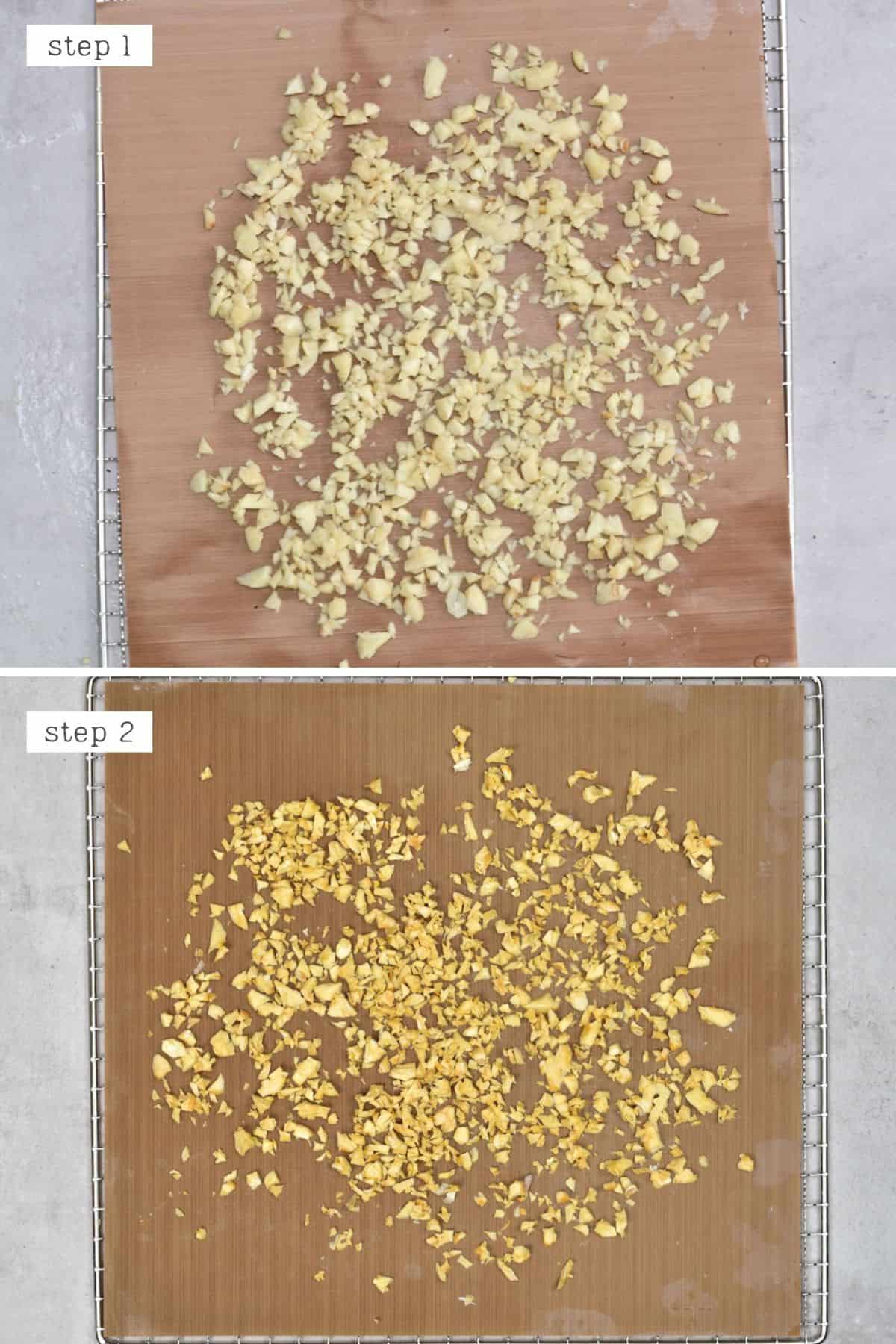
Check the garlic every hour (it takes 4-6 hours for me at 66ºC/150ºF) and remove it from the oven when it is either dry and snappable or at the very least barely bendy and lightly golden. It will continue to crisp up as it dries on the baking sheet.
Once cool, it should snap rather than bend. If not, then it’ll have to go back into the oven again.
To Air Dry
You can place the garlic pieces on a cloth or paper-lined baking sheet. I prefer to use a kitchen cloth.
Leave in a well-ventilated area, even better if it’s next to a window that gets plenty of sunshine. This is best for warmer, non-humid climates, as the weather and humidity will affect the amount of time they take to dry completely.
Turn over the garlic a couple of times. This will help speed up the drying process and stop them from sticking to the cloth/tray.
This method can take between 2-3 days based on the garlic slices’ thickness, the weather, and the humidity.
At this point the garlic flakes are ready.
Step 3: Grind the flakes into garlic powder
Use a coffee/spice grinder, high-speed blender/food processor, or mortar & pestle to grind the dehydrated garlic.
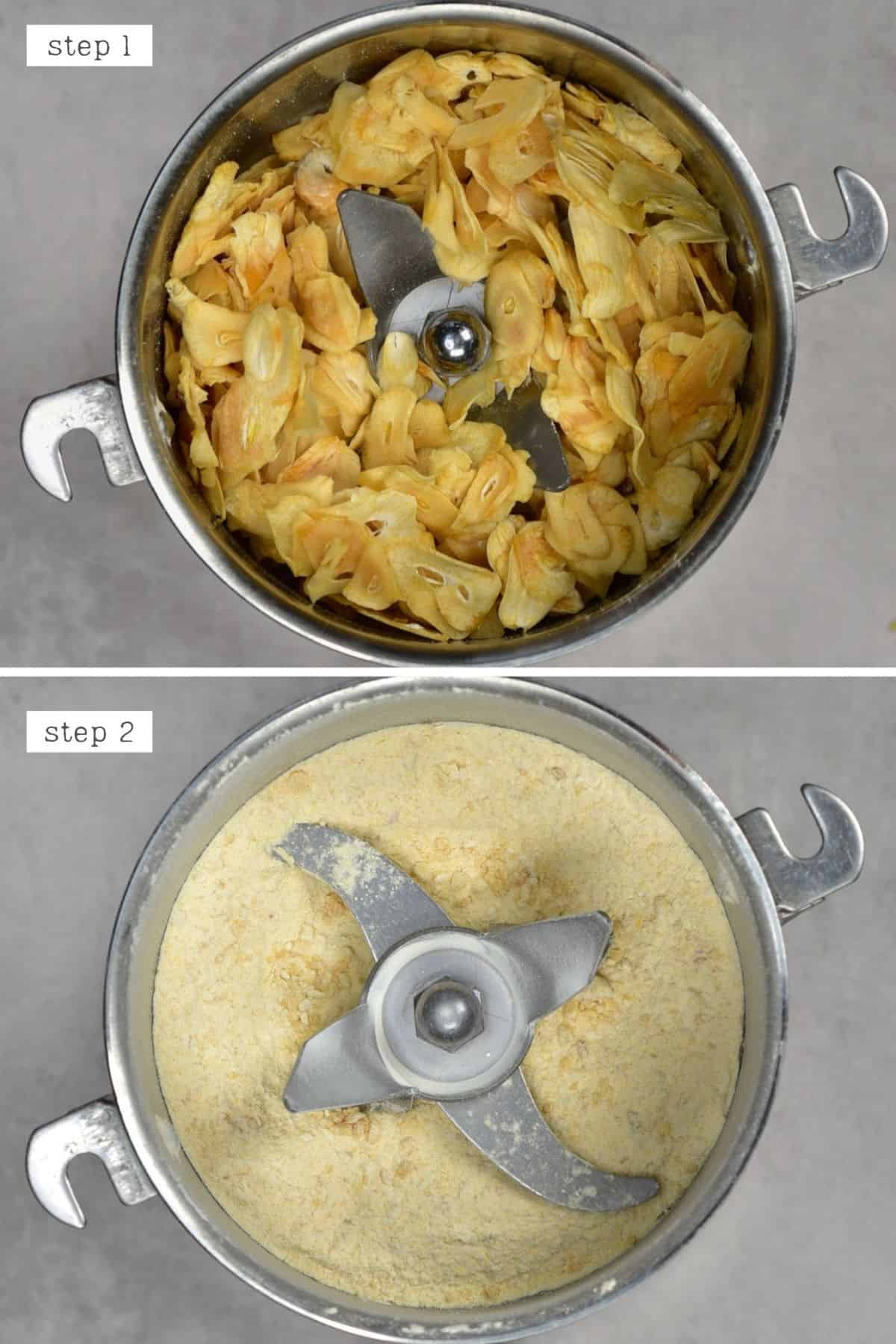
Once ground into a fine powder, sift it through a sieve, as there is always a few larger garlic ‘pebbles’ leftovers. These can be re-ground and sifted once more.
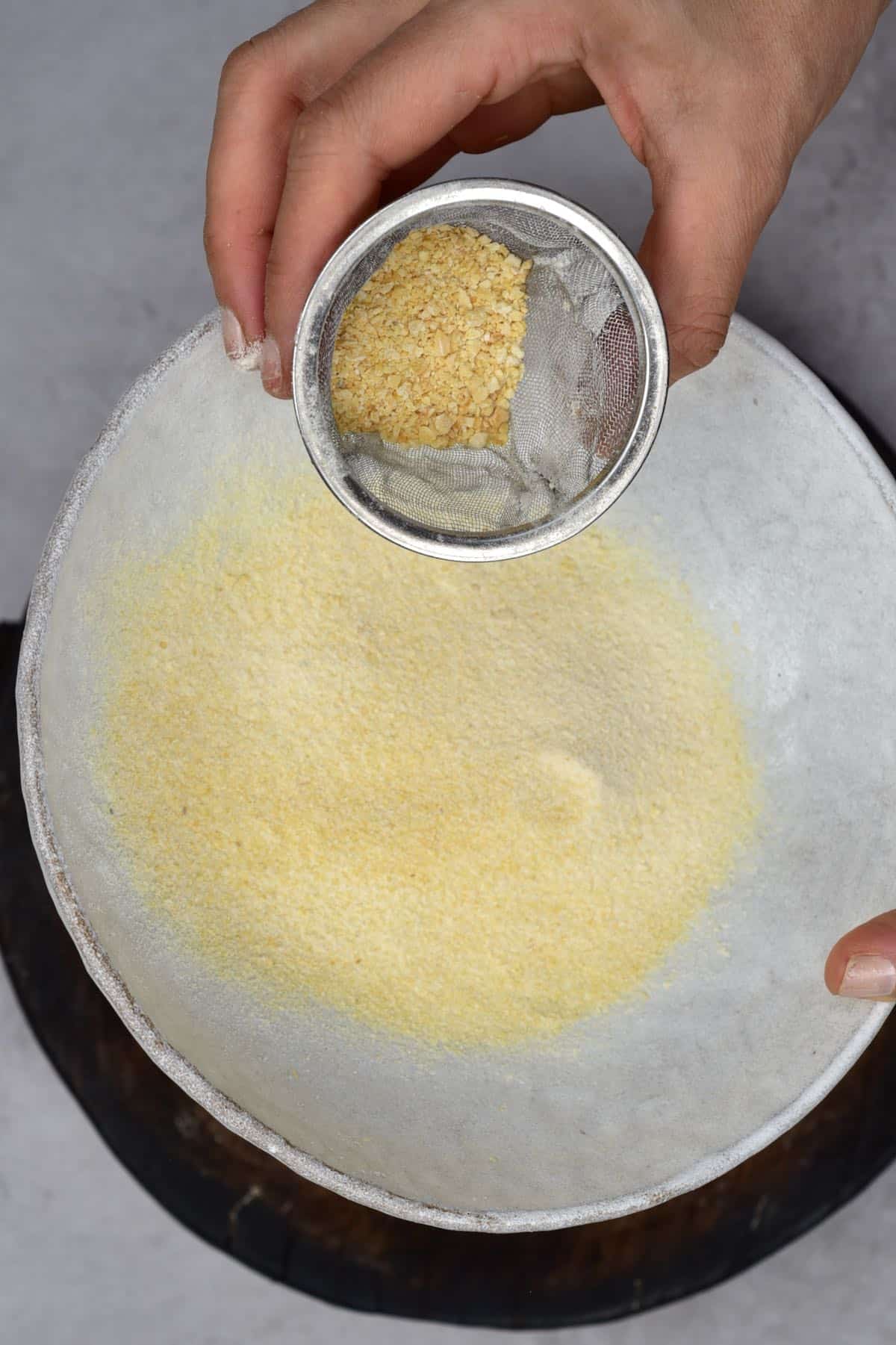
Any remaining chunkier pieces can be kept to one side to use in stocks or soups (as the liquid will rehydrate them, so they aren’t too hard) .
How To Store
The homemade garlic powder should be stored in an airtight glass jar/container in a cool, dry location – like the kitchen cupboard and will last indefinitely if stored well. Though, they are best used within a year as the flavor does begin to deteriorate after that.
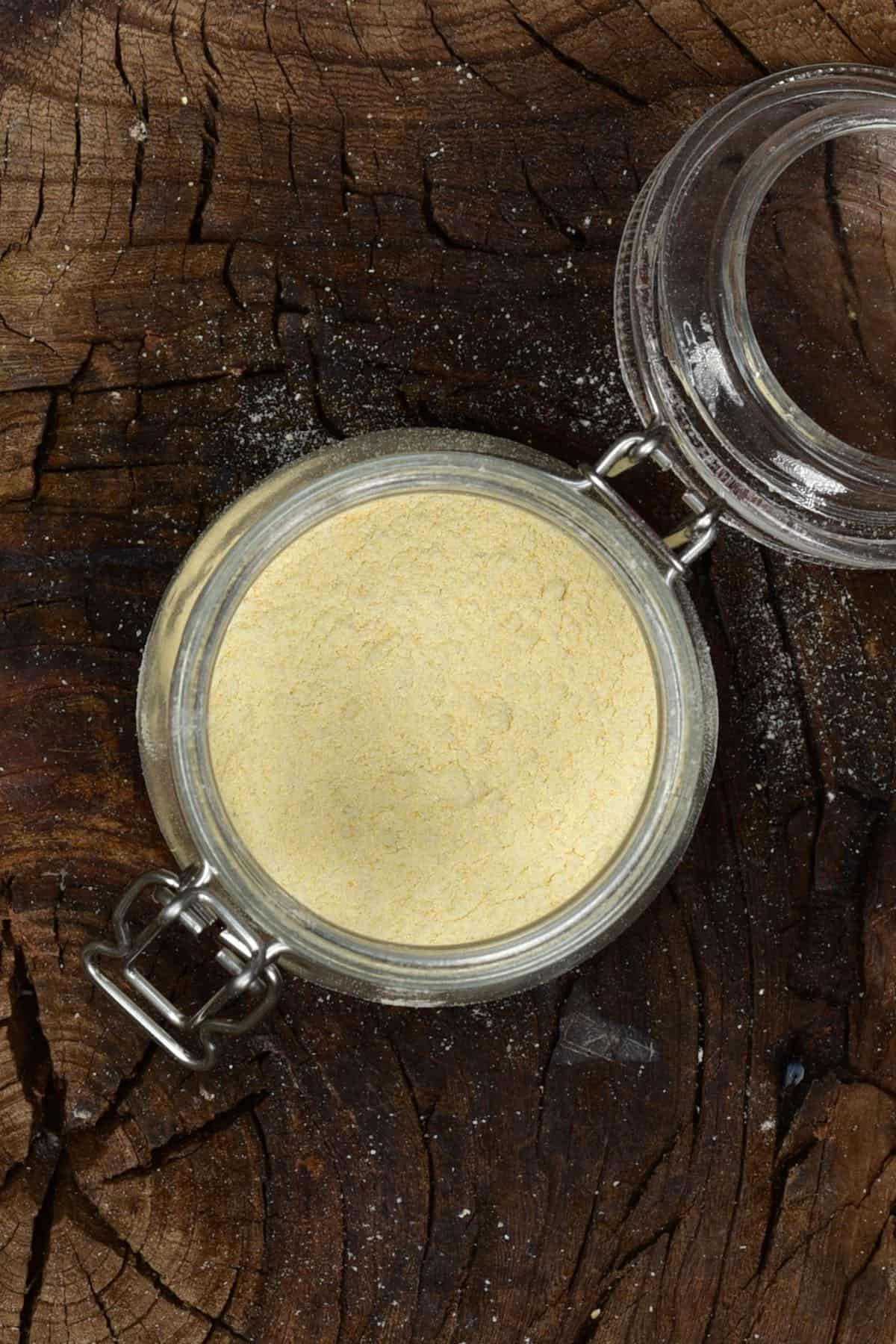
Within the first few days, I like to give the jar a shake daily to mix it all up. I’ve found this helps reduce any clumping, just in case there’s a little bit of moisture left in the garlic powder. You can also place some uncooked rice or beans into the container, which will absorb excess moisture.
How To Use
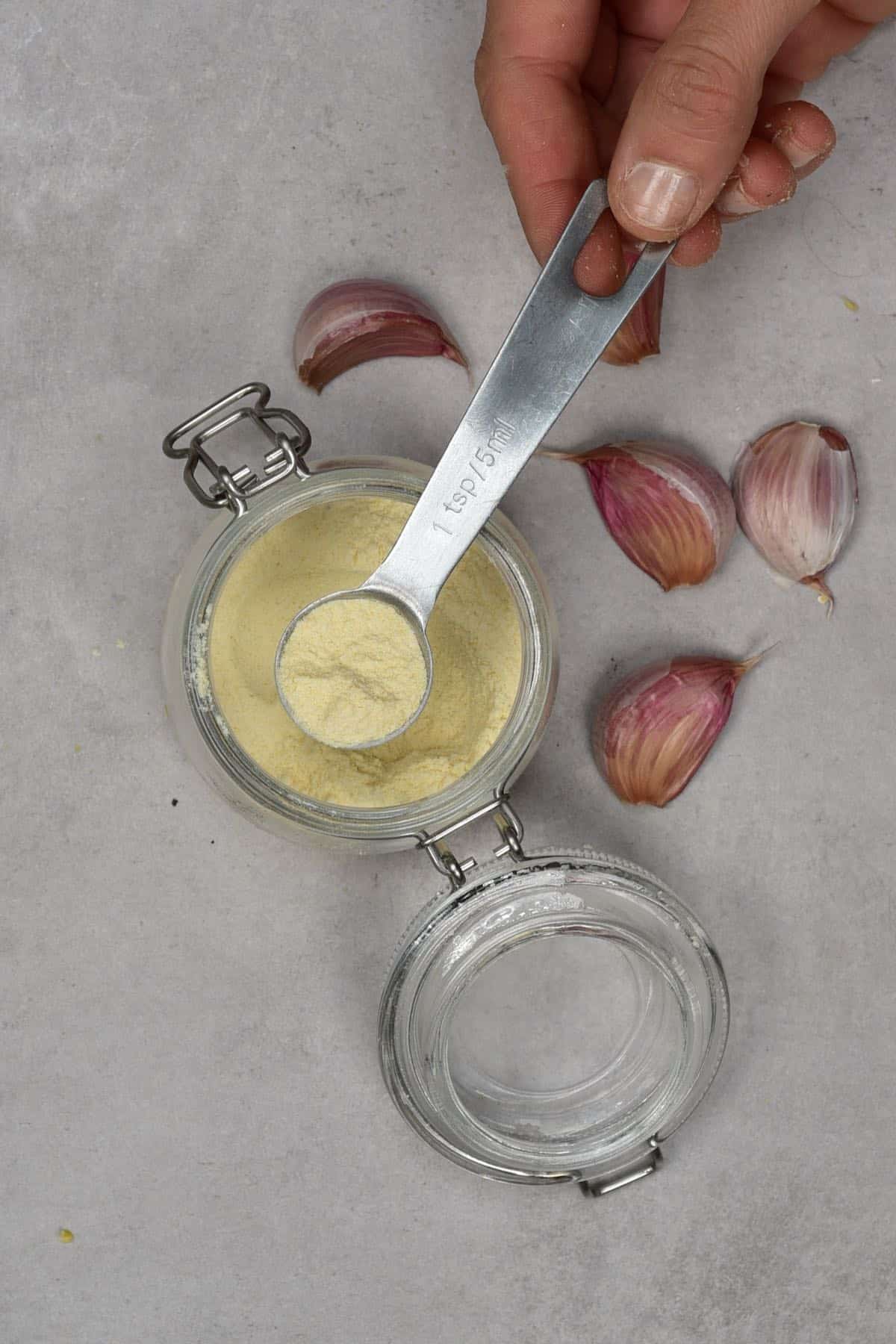
- In place of fresh garlic in recipes
- To season veggies and proteins – like these Rosemary Garlic Crispy Roasted Potatoes or this Simple Turmeric Roasted Cauliflower Head
- As part of a marinade for proteins– like homemade tofu.
- Within seasoning/ spice blends– like this Simple Homemade Italian Seasoning
- Dissolve into salad dressings, marinades, and sauces – like this Lemon Herb Tahini Sauce, Marinara Sauce, or Simple Roasted Red Pepper Sauce.
- Over or in egg dishes (F&P) – like scrambled, fried, soft/hard-boiled, as well as Omelettes.
- Sprinkle over snacks – like popcorn and pretzels.
- In dips or used to garnish (F&P) – like Rainbow Hummus 6 ways, Simple Spinach Yogurt Dip (Borani), or Smoky Eggplant Dip (Baba Ganoush).
- In or over bread and other savory baked goods (F&P) – like bagels, buns, or breads – like this Simple Homemade Multigrain Bread Recipe.
I practically use it as an all-purpose seasoning here. I sprinkle a little over lasagnas and pasta dishes, in baked potatoes, over roasted veggies, and more!
FAQs
Yes, of course. It’s often more concentrated in flavor, so you’ll need less of it (see below question).
When substituting garlic cloves to powder, approximately 1/8 teaspoon of garlic powder is the equivalent to one clove of garlic.
Garlic salt is a product that combines garlic powder and salt. To make garlic salt, mix them at a ratio of 3:1 parts salt to part garlic powder (i.e., 3 Tbsp salt to 1 Tbsp garlic powder).
Recipe Notes
- If you use the oven and the garlic browns, then the temperature is/was too high and the garlic will likely be bitter.
- It’s okay to turn the dehydrator/oven off overnight and restart the dehydrating process the following morning.
- Make sure the garlic is completely dry otherwise, it will clump. This is critical and makes a massive difference – so try not to be too impatient.
- During the dehydration period, the smell of garlic will be very prominent in your house – to be aware.
- Don’t throw out the ends and skins of the garlic. Place them in a bag in the freezer and use them the next time you make some homemade veggie stock.
- You can use a coffee grinder to grind this into powder. However, I only suggest doing so if you use it exclusively for spices and food uses.
- You can reduce the dehydrator’s temperature to preserve as much of the nutrition from the garlic as possible. However, the drying process will then take far longer. Use 38-43ºC/100-110°F (anything below 48ºC/118ºF will maintain as much of the nutritional properties as possible) and it will take between 1-3 days, depending on your particular dehydrator.
Related Recipes/DIYs
- DIY Garlic Flakes
- Simple Golden Spice (Golden Milk Powder)
- Simple Green Pea Powder
- How to Make Onion Powder
- How To Make Onion Flakes
- How To Crush, Chop, And Mince Garlic
If you try this garlic powder, then let me know your thoughts and questions in the comments. I’d also really appreciate a DIY rating and would love to see your recreations – just tag @AlphaFoodie.
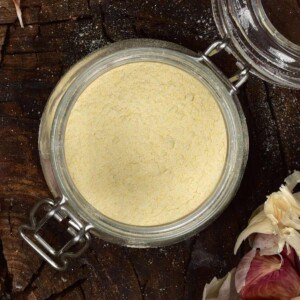
How To Make Garlic Powder
Equipment
Ingredients
- 3 garlic heads
232 grams fresh garlic yielded 90 grams of dried powder for me
Instructions
Step 1: Prepare the garlic.
- Peel the garlic cloves. I like to make this step faster by placing them in a large lidded container and shaking for 20-30 seconds, to loosen the skins.
- Slice or mince the garlic. You can slice it with either a garlic slicing tool, peeler, mandoline, or sharp knife. Alternatively, use a food processor/chopper and pulse until you have a chunky minced garlic consistency. Try to keep the slices even in thickness and no thicker than 1/8 inch at absolute maximum, 1/16 inch if you can manage it.
Step 2: Dehydrate the garlic
Using a dehydrator
- Lay the garlic slices onto the dehydrator trays, making sure that they don't touch and are in a single layer. The more space between them, the quicker they will dry.Dry in the dehydrator at 66ºC/150ºF for 6-8 hours (if high humidity, around 80%) or 4-6 hours (if low humidity).To check if they're ready, pick one up. If it's bendy at all, then it's not ready. If it snaps, then it's ready.
Using An Oven
- Spread the garlic over parchment-lined baking sheets, making sure the pieces don't touch.Place the trays in the oven at the lowest temperature your oven goes to. It's best if it's between 54-66ºC/130-150ºF. If your oven doesn't go as low as that, then choose the lowest temperature and prop open the door a few mm's*** to allow the steam to escape as the garlic dries and help the process along.
- Check the garlic every hour (it takes 4-6 hours for me at 66ºC/150ºF) and remove it from the oven when it is either dry and snappable or at the very least barely bendy and lightly golden. It will continue to crisp up as it dries on the baking sheet.Once cool, it should snap rather than bend. If not, then it’ll have to go back into the oven again.
To Air Dry
- You can place the garlic pieces on a cloth or paper-lines baking sheet. I prefer to use a kitchen cloth.Leave in a well-ventilated area, even better if it's next to a window that gets plenty of sunshine. This is best for warmer, non-humid climates, as the weather and humidity will affect the amount of time they take to dry completely.Turn over the garlic a couple of times. This will help speed up the drying process and stop them from sticking to the cloth/tray.This method can take between 2-3 days based on the garlic slices' thickness, the weather, and the humidity.
Step 3: Grind the flakes into garlic powder
- Use a coffee/spice grinder, high-speed blender/food processor, or mortar & pestle to grind the dehydrated garlic.Once ground into a fine powder, sift it through a sieve, as there is always a few larger garlic 'pebble' leftover. These can be re-ground and sifted once more.****
How To Store
- Store the homemade garlic powder in airtight containers like glass jars, and keep them in a cool, dry, and dark location – like a cupboard.Within the first few days, I like to give the jar a shake daily to mix it all up. I’ve found this helps reduce any clumping, just in case there’s a little bit of moisture left in the garlic powder. You can also place some uncooked rice or beans into the container, which will absorb excess moisture.The powder will keep well indefinitely in an airtight jar in your kitchen as long as it remains dry. Just keep it away from moisture. They’re best when used within the first year, though, as the flavor will deteriorate after that, I've found.
Notes
- If you use the oven and the garlic browns, then the temperature is/was too high and the garlic will likely be bitter.
- It’s okay to turn the dehydrator/oven off overnight and restart the dehydrating process the following morning.
- Make sure the garlic is completely dry otherwise, it will clump. This is critical and makes a massive difference – so try not to be too impatient.
- During the dehydration period, the smell of garlic will be very prominent in your house – to be aware.
- Don’t throw out the ends and skins of the garlic. Place them in a bag in the freezer and use them the next time you make some homemade veggie stock.
- You can use a coffee grinder to grind this into powder. However, I only suggest doing so if you use it exclusively for spices and food uses.
- You can reduce the dehydrator’s temperature to preserve as much of the nutrition from the garlic as possible. However, the drying process will then take far longer. Use 100-110°F (anything below 118ºF will maintain as much of the nutritional properties as possible). and it will take between 1-3 days, depending on your particular dehydrator.
Nutrition
Nutrition information is automatically calculated, so should only be used as an approximation.


